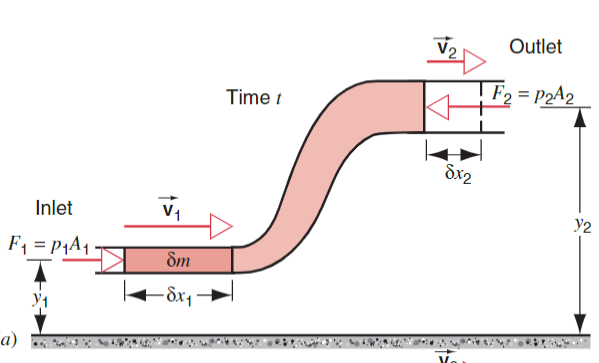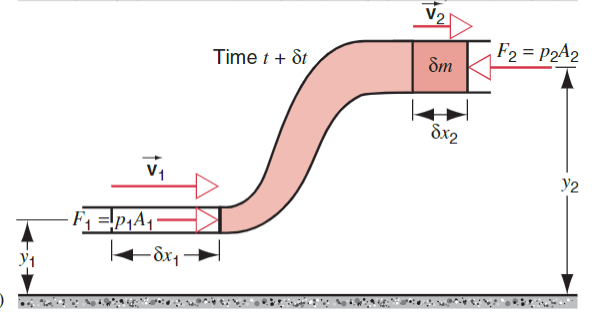As an Ideal Fluid flows through a pipe or Tube of Flow, it can change in several ways:
- The cross sectional area might change.
- The inlet and outlet may be at different elevations
- The inlet and outlet pressures may be different.
Using the Equation of Continuity for fluid flow:
We related change in area to changes in velocity. Change in pressure and elevation are both related to velocity, so each type are not independent of each other.
Deriving Bernoulli’s Equation
Lets use an example of a pipe:
 The pipe has cross-sectional area
The pipe has cross-sectional area
We will use Conservation of Energy to the system of the fluid between the inlet and outlet.
Lets say that there may be a pressure
Under both forces and gravity, we will say that the system moves to the right. The figure below shows the system after a time  In this time, the left side has moved an
In this time, the left side has moved an
There are three factors for the net External Work.
- At the inlet, the pressure force is:
- At the outlet, the pressure force is:
- Work done by gravity as a fluid element
moves through vertical displacement :
In Conservation of Energy,
The net external Work would be:
The volume of the shaded fluid element
The change in Kinetic Energy for
Applying conservation of energy:
And rearranging/cancelling:
Or:
This is Bernoulli’s Equation for ideal fluids, which state that the equation above is constant along a streamline.
Analyzing Bernoulli’s Equation
As we’ve seen, Bernoulli’s Equation is a derivation of conservation of energy. We can split it into types of energies:
is the Pressure Energy is the Kinetic Energy is the Potential Energy
Special Applications
- Static Pressure.
Static Pressure is simply a case where velocity is 0.
Which matches the equation we derived in Variation of Pressure for Fluids at Rest.
2. Dynamic Pressure.
Suppose a fluid flowing horizontally, so there is no difference in elevation:
In this equation, as the speed is large, pressure must be small, and vice versa. The quantity
3. Compressible, viscous flow.
If the fluid is compressible, then its Internal Potential Energy
If the flow is viscous, then the internal kinetic energy
Our complete analysis should include internal energy:
or:
If necessary, Bernoulli’s equation could be modified to account for theses other energy transformation.
Other Applications
The Venturi Meter The Pilot Tube Dynamic Lift Thrust on a Rocket